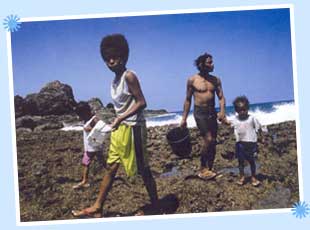Baler And Its Poeple, The Aurorans
by Ilovita Mesina
Geography accounts for the many traits that give individuality to a place and its people, and the same is true for Baler and its inhabitants. Located on the northern part of Quezon province and the eastern seaboard of Luzon, Baler lies majestically along the Sierra Madre and the Caraballo mountain ranges. Galo Gonzales, nostalgic of his hometown, describes Baler as a town that greets the Pacific. Father Leo McCrudden, a Carmelite missionary who died in Baler, saw it as a town that removed one from the cares and the noise of the city, beautiful and serene, a paradise. It was a poet's dream, tranquil and unhurried.
These statements describe Baler and its people before the onset of urbanization and technology. Aurora Province used to be just Baler and Casiguran. It enjoys the unique combination of four natural features that can ensure and sustain a bountiful existence if managed and harnessed accordingly: fertile and arable lands, mountains of dense forests, bordering coastlines, and rainfall that is evenly distributed throughout the year.
Long before the Spanish missionaries reached Baler and Casiguran in 1609, communities in the coastal areas and the mountains already existed. These were the Aeta and the Ilongot. A handful of Tagalogs came by way of Infanta and Palanan. They came in search of balatan, cola, and almaciga, which are forest products, and of course, the tapa or smoked venison meat made by the natives. The Ilongot would come down from the mountain when the weather condition was favorable and boat traders form Palanan and Isabela came with salt, bolos, and loincloth materials. Some of these traders found the place favorably habitable, married some of the natives, and decided to make their settlements in Baler.
When the Spanish missionaries settled in Baler, from 1609 to 1899, they brought with them Filipino acolytes and help. These triggered the arrival of migrants from other provinces. During those days, one could only access Baler and Casiguran by sea. The early settlers came from Laguna, Tayabas, Isabela, La Union, Ilocos, and the Bicol Region. Adverse weather conditions brought them to Baler. The Lumasacs, the Bihasas, and the Bitongs, were believed to be indigenous to Baler. It was said that the Lumasacs traced their roots to the Ilongots and the Bihasa to the Aetas. The first Bitong to arrive in Baler was said to have been from Liliw, Laguna. He was Jose Bitong. He befriended and Ilongot chieftain and married his daughter. Jose Bitong and Benito Silvestre were already in residence when the Spaniards opened the mission of San Jose de Casecnan in 1753. He was made capitan del pueblo or town captain.
The Molinas, form which the Aragons, Carrascos, and Quezons descended, were said to have come from Isabela, then settled in Casiguran and later in Baler. The Pobletes came from Infanta, the Ferreras from Gumaca, Tayabas, the Querijeros from Bulacan, the Guerreros from Ilocos, and the Catipons, Huertalexas, and Palipsis from Laguna. The Valenzuelas were pot traders from Tiwi, Albay, and were brought to and stranded in Baler due to bad weather. They then married the natives and settled there.
Lucio Quezon, a retired Spanish sergeant, was a boat captain from Infanta. He traded in balatan, cola, and almaciga, when he came to Baler and there married Maria Dolores Molina. Other families like the De la Torres, Gallegos, Pobres, and Fernandezes, were believed to have descended from the Spanish friars assigned to Baler. A number of Balerenos had Spanish blood, and foremost among them were the Quezons, Aragons, Angaras, Carrascos, and the Valenzuelas. There were claims that the Angaras were from Pangasinan, but Andres Angara, a former World Health Organization director, believed that the Pangasinan line came from Casiguran. Alex Penaranda, an Angara descendant on his mother's side, claimed that the first Angara to arrive in Baler was a maestro publico or public teacher, and he came with a Spanish friar. The Angaras who descended from Nicoloasa Calderon and Candido Angara had Ferreras, Poblete, and Guerrero roots.

In 1896, a group of Ilocanos from Aringay, La Union, headed by Macario Avena Fontanilla, came to settle in San Jose. He was accompanied by Juan Jopson and Pantaleon Dulay. In 1906, another group of Ilocanos arrived from La Union and Pangasinan. They heard about a place of promise and opportunity where land could be acquired by everybody. They hiked all the way from La Union for eleven days, hiking in groups for fear of the Iiongots. The groups were comprised of the Gatchalians, Diazes, Olpindos, Abubos, Fontanillas, and Fragillanas. They became the early settlers of San Jose, now Maria Aurora. Their arrival facilitated the opening of the Baler-Bongabon Road, at the insistence of Dona Aurora Aragon Quezon.
